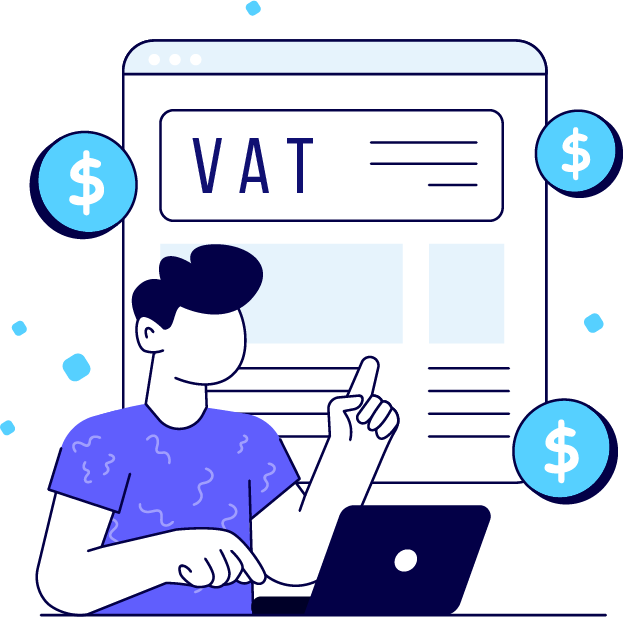Table of Content
Share This Article
- Reading Time: 6 Minutes
- Published: June 16, 2022
- Last Updated: February 13, 2025
VAT is the acronym for value-added tax, which was introduced in 1973. VAT is a tax on purchasing goods or services and other taxable supplies. Consumers and manufacturers ultimately pay the tax amount, not the manufacturers or producers. The businesses collect and pay it to Her Majesty’s Revenue and Customs (HMRC). Thus, VAT is an indirect tax because the businesses collect it on behalf of the government. Businesses with a turnover of more than £85,000 register for VAT. A business over this threshold must be registered to charge VAT on all the goods and services offered. The UK VAT guidelines also allow businesses to reclaim VAT on goods and services purchased for the business. To know more about the reclaiming of VAT and other related information, you can refer to our previous blog – UK VAT Explained for Beginner! In the same blog, we also discussed why voluntarily registering for VAT is beneficial.
A business that is registered under VAT gets a VAT number which can be found on the registration certificate. In addition, VAT-registered businesses must report the amount of VAT charged or paid to HMRC through a VAT return. This process should be completed once every three months. The UK VAT guidelines provide specified rates to be charged by the businesses.
Types of VAT Rates in the UK
1. Standard rate (@20%)- It is charged mostly on all goods or services and other taxable supplies (except those covered under reduced rate and zero-rated supplies).
2. Reduced rate (@5%)- It is charged on children’s car seats, electricity, natural gas, district heating supplies (for domestic purposes only), LPG and heating oil (for domestic purposes only), certain renovations and repairs of private dwellings, and certain medical equipment for disabled individuals.
3. Zero-rated supplies- It includes the following categories:
a. Food and drinks for human consumption- All food items are zero-rated supplies except catering, alcoholic drinks, confectionery, crisps and savoury snacks, hot food, sports drinks, hot takeaways, ice cream, soft drinks and mineral water (these items are liable to a standard rate of 20%). Certain supplies of catering and hot takeaway food will be liable for the reduced rate of 5%. In addition, certain animals, animal feeding products, plants and seeds are also included under zero-rated supplies (subject to conditions specified in the VAT notices).
b. Health, education, welfare and charities- The health sector includes incontinence products, maternity pads, sanitary protection products, and prescriptions by a registered pharmacist. The welfare part includes equipment for blind or partially sighted people or disabled people and aids for blind people. Zero-rated supplies include advertising services for charities, fund-raising events for charities, charitable donations, and construction and sale of new buildings for charitable purposes.
c. Printing, postage, and publications- It includes brochures, leaflets, pamphlets, books, children’s painting and picture books, maps and charts, magazines, newspapers, printed or copied music and publications (includes standard-rated items).
d. Children’s clothing and footwear, protective and safety equipment- It includes babywear, children’s clothes and footwear. Also, cycle helmets are CE marked, motorcycle helmets, protective boots and helmets for industrial use.
4. Exempt supplies- Exempt supplies are entirely excluded from the UK VAT guidelines. A business that sells only VAT-exempt items that cannot be registered under VAT is known as a VAT-exempt business. Exempt supplies make the necessary goods or services more accessible to the general public. It includes the following items:
- Insurance
- Health services offered by doctors
- Postage stamps or services
- Granting credit loans
- Donations to a charity (if nothing is received in return), etc
The list mentioned above is not exhaustive. To understand in detail, contact your tax consultant or refer to www.gov.uk.
As per the UK VAT guidelines, a registered business charges VAT from customers keeps VAT records and pays the VAT to the HMRC. There are some VAT schemes to choose from. Businesses can choose the one which is best for their business and income. But a business owner often forgets to pick a VAT scheme suitable for their business. Let us learn about the common VAT schemes available.
1. Flat rate scheme- In this scheme, a business only calculates the VAT paid to HMRC as a percentage of the annual turnover. The actual flat rate to be used by businesses depends on the industry. Since the businesses pay VAT to HMRC at a flat rate, they can keep the difference if more VAT is collected from the customers. Unlike the standard VAT accounting, business owners cannot reclaim VAT paid on purchases except for capital assets worth more than £2,000. The eligibility to use the flat rate scheme is that a business must be VAT registered with a turnover of less than £150,000(excluding VAT).
Benefits:
a. No need to record VAT charged on every sale and purchase.
b.1% reduction in the flat rate percentage for the first year of VAT registration.
c. Businesses get a sense of certainty because they always know what percentage is to be paid to the HMRC.
2. Annual accounting scheme- VAT is paid on account in this scheme, suggesting that VAT can be either paid in nine monthly or three quarterly instalments. After that, a single annual VAT return is submitted. However, a scheme like this would not suit a business that reclaims VAT regularly because that particular business will get one refund a year (when it submits the VAT return). The eligibility to join the annual accounting scheme is when the estimated taxable turnover is £1.35 million or less. An annual accounting scheme is intended to help with the budgeting and cash flow and minimise paperwork.
Benefits:
a. Only a single VAT return is to be submitted.
b. Businesses get to know about the cash flow in advance.
c. VAT returns can be prepared at the same time as the annual accounts.
3. Cash accounting scheme- In this scheme, VAT is recorded based on payments made or received. The VAT cash accounting scheme follows the principles of cash accounting, which means that income is recorded as soon as it is received, and expenses are recorded in the period they are paid. However, a business need not inform HMRC to join the cash accounting VAT scheme. A business willing to join must do so at the start of a new VAT accounting period. Similarly, if a business leaves the scheme, it must be done at the end of the accounting period.
4. VAT retail scheme- In this scheme, businesses calculate the VAT dues by various methods. Using a VAT retail scheme allows businesses to calculate the value of total taxable sales for a particular period. With this, a business can calculate all the VAT dues simultaneously with each VAT return instead of calculating it with every sale. Businesses can join VAT retail schemes at the beginning of any VAT period, and there is no compulsion to inform HMRC about it. However, businesses cannot use a VAT retail scheme with flat rate schemes. Three standard VAT retail schemes exist the point-of-sale scheme, apportionment scheme, and direct calculation scheme.
5. VAT margins scheme- A scheme like this can be used by business owners who sell second-hand goods, works of art, antiques, and other collectors’ items. This scheme is used to tax the difference between the amount a business pays for specific items and the amount in which those items are sold. On this difference, a VAT at the rate of 16.67%. To use the scheme, businesses do not have to apply anywhere but rather keep a record of sales and purchases. A business that sells high volumes of low-priced qualifying items may be eligible to use a simplified VAT margin scheme known as a Global accounting scheme.
FINAL WORDS
The VAT explained above is relatively straightforward; however, each scheme has pros and cons. To get the best consultation, it is better to seek professional advice to choose the best UK VAT scheme per the business situation. Different types of schemes suit various types of business. Therefore, a professional in the respective field would be a great help. The process becomes burdensome, especially if you are a small business owner focusing on expanding a business. We at Whiz Consulting can help you with the process and your accounting and bookkeeping function to achieve overall business growth.

Get customized plan that supports your growth

Thousands of business owners trust Whiz to manage their account
Let us take care of your books and make this financial year a good one.








